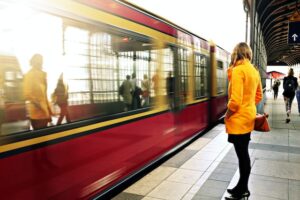Finding sustainable mobility choices becomes more crucial as metropolitan areas and populations continue to develop. People movers are one solution that has been gaining favour. These cutting-edge mobility options have a number of advantages, including affordability and environmental friendliness. In this article, we’ll examine the benefits of employing people movers in cities and how they’re used in other parts of the world. So fasten your seatbelts and prepare for a journey to a future that is more sustainable!
A people mover is what?
A personal rapid transit (PRT) system, often known as a people mover, is a type of automated transportation that typically runs on an elevated track or guideway. People movers are intended to transport small groups of passengers straight to their destination without making any intermediate stops, in contrast to conventional mass transit systems like buses and trains.
These little cars are frequently powered by electricity and may hold two to six passengers. They fluidly navigate the network of tracks in metropolitan areas using sensors and computer control systems. At designated stations, passengers can either call for the car or use an app on their smartphone.
Depending on the requirements of each city, people movers are available in a variety of forms and configurations. While some models make use of already-built infrastructure, others demand wholly new development. These systems are successful in many cities because they are effective, inexpensive, and convenient for commuters.
People movers offer a special remedy for the transportation problems that highly populated urban areas experience all over the world, learn more about people movers via this website.

The advantages of using people movers in cities
Urban regions have unique transportation problems that can be solved by using people movers. They are a great option for both city planners and commuters since they provide a number of advantages.
One of the main benefits of utilising people movers is their effectiveness in moving huge groups of people. As a result, there will be fewer vehicles on the road, less traffic, and better air quality. People movers are a highly effective option for mass transit demands because they can transport hundreds or even thousands of passengers each hour.
People movers boost commuter safety in addition to easing traffic and enhancing air quality. These systems run in designated lanes or tracks that are isolated from other traffic, including people. This reduces accidents brought on by distractions or human error.
People movers also save money as compared to more conventional forms of transportation. Since they run on designated tracks without interference from other vehicles or pedestrians, they require less maintenance than buses or trains. They also substitute power for fossil fuels, which lowers operational expenses and increases sustainability.
Cities may easily implement specialised solutions based on their own demands because people movers can be customised according to needs such as distance travelled, capacity needed, etc.
People mover systems are a desirable alternative for future urban transport networks because of their advantages!
The affordability of people movers
Due to its affordability, people movers are becoming more and more popular in metropolitan settings. The fact that people movers require less maintenance than conventional modes of transportation like buses and trains is one of the key advantages of employing them. This translates into lower long-term expenses for maintaining and fixing these automobiles.
The fact that people movers can carry numerous passengers at once is another factor contributing to their affordability. As a result, fewer journeys are required, which lowers the cost of operations. Additionally, compared to other forms of transportation, people movers frequently consume less energy, which over time lowers fuel expenses.
The labour costs involved with operating people mover systems are also much reduced because they are automated and do not require drivers or conductors. They are therefore a desirable choice for municipal planners who want to cut costs while still offering citizens effective mobility.
Maintenance of people movers
One of the most important advantages people movers offer urban areas is their sustainability. These means of transportation, as opposed to conventional cars, are intended to be more eco-friendly and energy-efficient.
In contrast to gasoline-powered cars, people movers often run on electricity or other renewable fuels. As a result, they leave a smaller carbon footprint and contribute less to air pollution, a major issue in numerous cities all over the world.

Additionally, people movers frequently follow set routes with planned stops, which makes them perfect for public transportation networks. They can aid in the reduction of traffic congestion and the promotion of sustainable mobility solutions by providing an alternate form of transportation to private vehicles.
Their capacity to transport huge groups of individuals simultaneously is another facet of their sustainability. People movers take up less space on the road or rail than conventional buses or trains while carrying more passengers. They consequently lessen the requirement for additional infrastructure like roads and rail lines.
People movers are a desirable alternative for urban planners looking to develop more sustainable transport networks because of the sustainability advantages they offer. There is no denying that this form of transport has grown in popularity over the past few years due to their low environmental impact and effectiveness in moving huge numbers of passengers quickly and safely across crowded urban areas!



